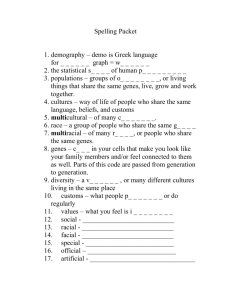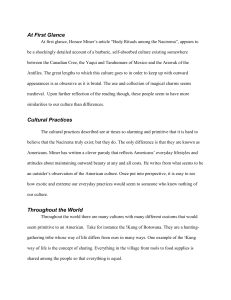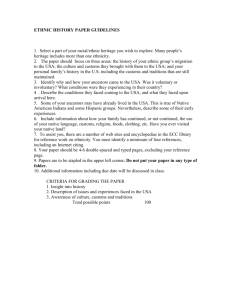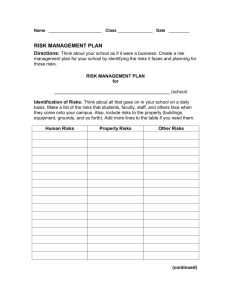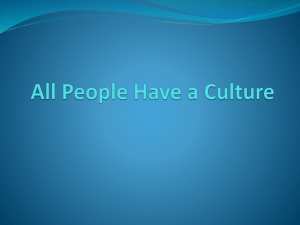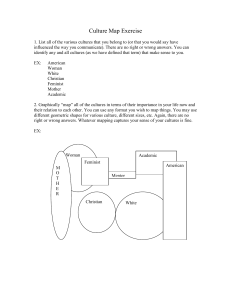Role of Culture in the Production, Distribution, and - Tobe-HSB
advertisement
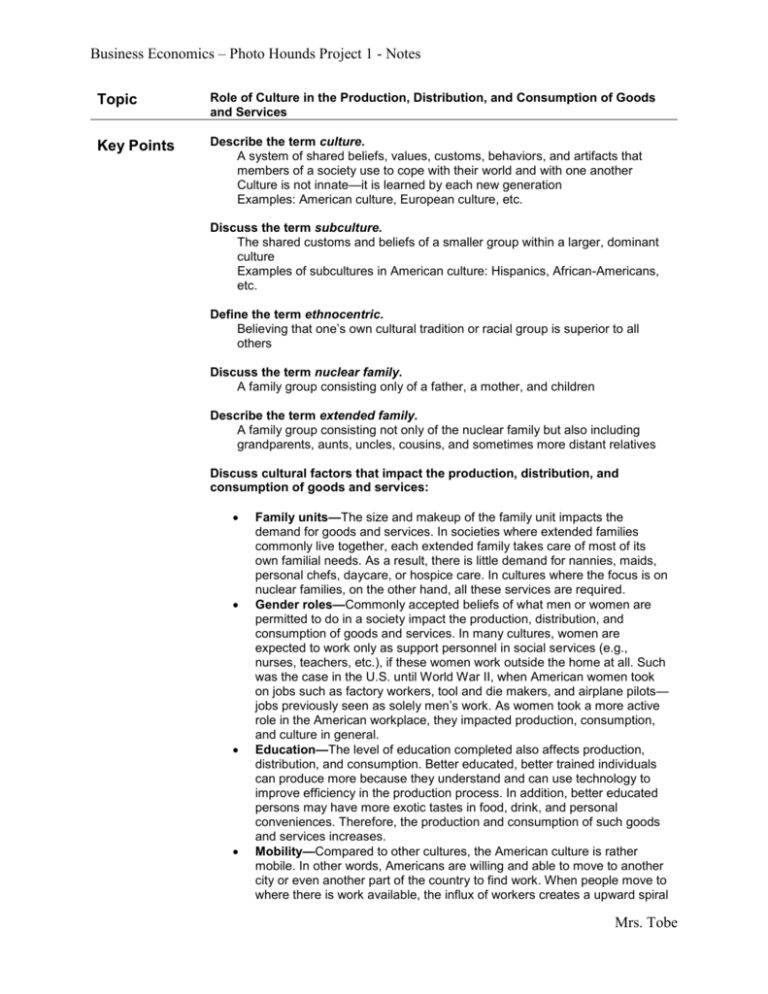
Business Economics – Photo Hounds Project 1 - Notes Topic Role of Culture in the Production, Distribution, and Consumption of Goods and Services Key Points Describe the term culture. A system of shared beliefs, values, customs, behaviors, and artifacts that members of a society use to cope with their world and with one another Culture is not innate—it is learned by each new generation Examples: American culture, European culture, etc. Discuss the term subculture. The shared customs and beliefs of a smaller group within a larger, dominant culture Examples of subcultures in American culture: Hispanics, African-Americans, etc. Define the term ethnocentric. Believing that one’s own cultural tradition or racial group is superior to all others Discuss the term nuclear family. A family group consisting only of a father, a mother, and children Describe the term extended family. A family group consisting not only of the nuclear family but also including grandparents, aunts, uncles, cousins, and sometimes more distant relatives Discuss cultural factors that impact the production, distribution, and consumption of goods and services: Family units—The size and makeup of the family unit impacts the demand for goods and services. In societies where extended families commonly live together, each extended family takes care of most of its own familial needs. As a result, there is little demand for nannies, maids, personal chefs, daycare, or hospice care. In cultures where the focus is on nuclear families, on the other hand, all these services are required. Gender roles—Commonly accepted beliefs of what men or women are permitted to do in a society impact the production, distribution, and consumption of goods and services. In many cultures, women are expected to work only as support personnel in social services (e.g., nurses, teachers, etc.), if these women work outside the home at all. Such was the case in the U.S. until World War II, when American women took on jobs such as factory workers, tool and die makers, and airplane pilots— jobs previously seen as solely men’s work. As women took a more active role in the American workplace, they impacted production, consumption, and culture in general. Education—The level of education completed also affects production, distribution, and consumption. Better educated, better trained individuals can produce more because they understand and can use technology to improve efficiency in the production process. In addition, better educated persons may have more exotic tastes in food, drink, and personal conveniences. Therefore, the production and consumption of such goods and services increases. Mobility—Compared to other cultures, the American culture is rather mobile. In other words, Americans are willing and able to move to another city or even another part of the country to find work. When people move to where there is work available, the influx of workers creates a upward spiral Mrs. Tobe Business Economics – Photo Hounds Project 1 - Notes effect in the production and consumption of other needed goods and services, thus boosting the entire economy of that region. The parts of the country that people leave are negatively affected, though, because as jobs disappear and people move away, the businesses that served those people also suffer. Many of these businesses are forced to downsize or shut down, putting more people out of work and creating a downward spiral for that area’s economy. Social class—Social class refers to the informal ranking of people in a culture based on their income, occupation, education, dwelling, and other factors. Examples include the working class, middle class, upper class, etc. The higher the social class, the greater the demand for luxury goods such as high-end automobiles, vacation homes, etc. Communication/Language—In the increasingly diverse American society, many businesses have profited by expanding the range of goods and services that they offer. Most U.S. grocery stores now offer an array of foreign foods for the increasing Hispanic-American and Asian-American populations, and many businesses have hired bilingual employees to communicate with non-English speaking customers. Religion—A society’s predominant religion has an impact on the demand and consumption of certain goods and services. In America, where the majority of citizens say they are Christian, there are many churches, religious television channels, and Christian religious items available. Burqas, however, are not produced in large quantities in the U.S., because the U.S. Moslem population is small when compared to the Christian population. In predominantly Islamic societies, the exact opposite is true. Churches and Christian religious items are in very small supply in those societies. Instead, mosques, Moslem television stations, and Islamic religious items are the norm. Values and attitudes—What a culture generally deems valuable and important affects the production, distribution, and consumption of goods and services. In the U.S., some of the things that many people value are violence, physical beauty, and celebrities. For that reason, violent video games, violent sports, cosmetic surgery, Barbie dolls, and fashion and celebrity magazines are produced and consumed at a rapid pace. Color—Color preferences vary from culture to culture. In Islamic cultures, for instance, the color red is not very popular. Instead, more sober colors such as black are preferred. This cultural preference greatly impacts clothing and textile production in such cultures. Customs—Customs—the habits or practices followed by people of a particular culture or region—also impact the production, distribution, and consumption of goods and services. Some customs that many Americans seem to practice are owning guns and using automobiles for transportation. In European culture, however, these customs are very rare. In Europe, very few people own guns, and most Europeans use mass transportation such as trains or buses to get from place to place. Customs such as these have a huge impact on the gun and automobile industries. Describe cultural changes that have impacted the production and consumption of goods and services. The civil rights and equal rights movements have had an impact on the production and consumption of goods and services. As the rights and roles of women, blacks, and other minorities have increased, so has these person’s participation in the production and consumption of goods and services. The rise in gas prices during the past few years has also affected Mrs. Tobe Business Economics – Photo Hounds Project 1 - Notes production and consumption. With gas prices rising ever higher, consumers are switching from SUV’s and large trucks to hybrid vehicles. The green movement has also impacted production and consumption, because as people have become more environmentally conscious, the demand for recycled products has sharply increased. Discuss how the U.S. and less-developed countries (LDCs) answer the three basic economic questions: 1. What to produce? 2. How to produce? 3. For whom to produce? In the U.S.: Economic decisions are the result of individual decisions made by buyers and sellers in the marketplace In less-developed countries (LDCs): Tradition determines what will be produced, how to produce it, and for whom to produce it. In other words, in areas of Africa, Central and South America, Eastern Europe, and rural China, people continue to produce what their parents and grandparents and great-grandparents produced because that is what they have the tools, knowledge, and climate to produce. In the Congo, for example, people grow vegetables using animal-powered machinery (e.g., plows, reapers, etc.) because that’s what their families have always used, and they grow the vegetables to sustain themselves, not to send to market, because that’s what their families have always done. Mrs. Tobe

